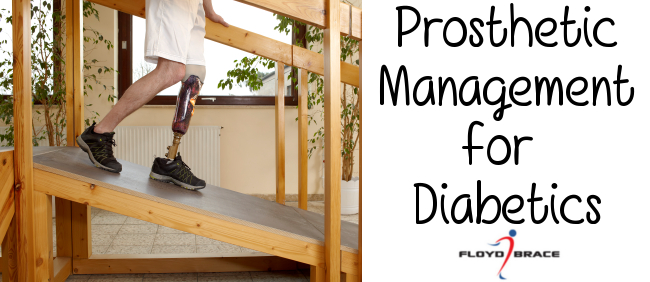Those who suffer from diabetes need to take extra care when it comes to preventing wounds, accidents and injuries. Although diabetes can be managed with the proper care and diet, sometimes it just isn’t enough. When despite all best efforts amputation becomes necessary, we at Floyd Brace are ready step in with the appropriate level of prosthetic care.
Those who require a prosthetic limb from complications with diabetes may have a few different requirements and maintenance procedures when it comes to caring for yourself and the prosthesis. Here are some things to keep in mind when thinking about prosthetic management for diabetics:
Timing – Slow wound healing is a hallmark of advanced diabetes, especially in the lower limb. A commonly accepted guideline is to begin the transition to a prosthesis about six weeks after surgery, barring lingering complications.
Limb components – Light weight, durability and ease of use are important attributes of prosthetic legs for diabetic patients. Because sores and infection occur frequently in neuropathic limbs, optimal socket design and cushion liners are important considerations. Flexible, dynamic sockets help prevent undue pressure over sensitive skin and nerve areas. A lightweight prosthetic foot appropriate to the amputee’s activity level will help maximize the benefit the older diabetic patient receives from a prosthetic limb.
Continuing care – Amputees with diabetes present special challenges and thus require more frequent prosthetic follow-up care than most other clients. Diabetic limbs frequently exhibit reduced perspiration and loss of skin moisture, leaving tissue prone to skin breakdown and infection. Regular inspection of the residual limb and adjoining skin surfaces is thus essential.
It is critical for amputees with diabetes to diligently examine their remaining sound limb daily, checking for sores, cuts, blisters, as well as foreign items in their shoe to keep that good leg healthy. Circulation in a sound limb can be improved by wiggling the toes for a few minutes several times a day, moving the ankle joint up and down periodically, and not crossing the legs for an extended time.
For answers to specific questions regarding orthotic/prosthetic care of patients with diabetes, please feel free to contact us today!
Tags: diabetes, prosthetic management


Recent Comments